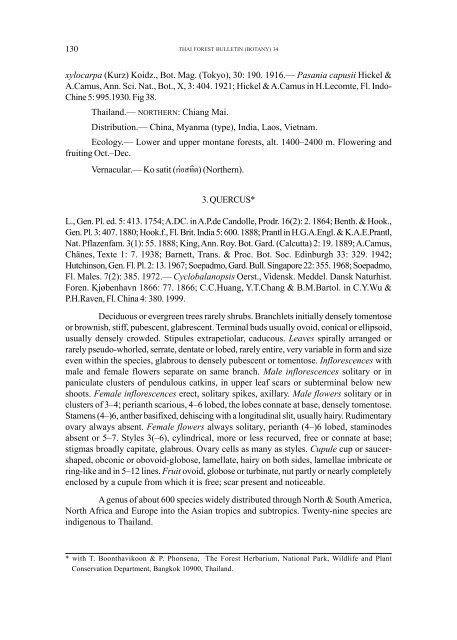A synoptic account of the Fagaceae of Thailand
A synoptic account of the Fagaceae of Thailand
A synoptic account of the Fagaceae of Thailand
You also want an ePaper? Increase the reach of your titles
YUMPU automatically turns print PDFs into web optimized ePapers that Google loves.
130<br />
THAI FOREST BULLETIN (BOTANY) 34<br />
xylocarpa (Kurz) Koidz., Bot. Mag. (Tokyo), 30: 190. 1916.— Pasania capusii Hickel &<br />
A.Camus, Ann. Sci. Nat., Bot., X, 3: 404. 1921; Hickel & A.Camus in H.Lecomte, Fl. Indo-<br />
Chine 5: 995.1930. Fig 38.<br />
<strong>Thailand</strong>.— NORTHERN: Chiang Mai.<br />
Distribution.— China, Myanma (type), India, Laos, Vietnam.<br />
Ecology.— Lower and upper montane forests, alt. 1400–2400 m. Flowering and<br />
fruiting Oct.–Dec.<br />
Vernacular.— Ko satit (°àÕ ∑‘µ) (Nor<strong>the</strong>rn).<br />
3. QUERCUS*<br />
L., Gen. Pl. ed. 5: 413. 1754; A.DC. in A.P.de Candolle, Prodr. 16(2): 2. 1864; Benth. & Hook.,<br />
Gen. Pl. 3: 407. 1880; Hook.f., Fl. Brit. India 5: 600. 1888; Prantl in H.G.A.Engl. & K.A.E.Prantl,<br />
Nat. Pflazenfam. 3(1): 55. 1888; King, Ann. Roy. Bot. Gard. (Calcutta) 2: 19. 1889; A.Camus,<br />
Chänes, Texte 1: 7. 1938; Barnett, Trans. & Proc. Bot. Soc. Edinburgh 33: 329. 1942;<br />
Hutchinson, Gen. Fl. Pl. 2: 13. 1967; Soepadmo, Gard. Bull. Singapore 22: 355. 1968; Soepadmo,<br />
Fl. Males. 7(2): 385. 1972.— Cyclobalanopsis Oerst., Vidensk. Meddel. Dansk Naturhist.<br />
Foren. Kjøbenhavn 1866: 77. 1866; C.C.Huang, Y.T.Chang & B.M.Bartol. in C.Y.Wu &<br />
P.H.Raven, Fl. China 4: 380. 1999.<br />
Deciduous or evergreen trees rarely shrubs. Branchlets initially densely tomentose<br />
or brownish, stiff, pubescent, glabrescent. Terminal buds usually ovoid, conical or ellipsoid,<br />
usually densely crowded. Stipules extrapetiolar, caducous. Leaves spirally arranged or<br />
rarely pseudo-whorled, serrate, dentate or lobed, rarely entire, very variable in form and size<br />
even within <strong>the</strong> species, glabrous to densely pubescent or tomentose. Inflorescences with<br />
male and female flowers separate on same branch. Male inflorescences solitary or in<br />
paniculate clusters <strong>of</strong> pendulous catkins, in upper leaf scars or subterminal below new<br />
shoots. Female inflorescences erect, solitary spikes, axillary. Male flowers solitary or in<br />
clusters <strong>of</strong> 3–4; perianth scarious, 4–6 lobed, <strong>the</strong> lobes connate at base, densely tomentose.<br />
Stamens (4–)6, an<strong>the</strong>r basifixed, dehiscing with a longitudinal slit, usually hairy. Rudimentary<br />
ovary always absent. Female flowers always solitary, perianth (4–)6 lobed, staminodes<br />
absent or 5–7. Styles 3(–6), cylindrical, more or less recurved, free or connate at base;<br />
stigmas broadly capitate, glabrous. Ovary cells as many as styles. Cupule cup or saucershaped,<br />
obconic or obovoid-globose, lamellate, hairy on both sides, lamellae imbricate or<br />
ring-like and in 5–12 lines. Fruit ovoid, globose or turbinate, nut partly or nearly completely<br />
enclosed by a cupule from which it is free; scar present and noticeable.<br />
A genus <strong>of</strong> about 600 species widely distributed through North & South America,<br />
North Africa and Europe into <strong>the</strong> Asian tropics and subtropics. Twenty-nine species are<br />
indigenous to <strong>Thailand</strong>.<br />
* with T. Boonthavikoon & P. Phonsena, The Forest Herbarium, National Park, Wildlife and Plant<br />
Conservation Department, Bangkok 10900, <strong>Thailand</strong>.
















